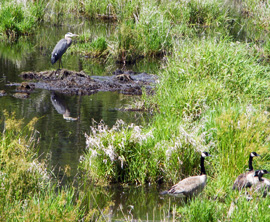
If you have a stream, creek, river, or wetland on your property, you have something special in your care. Cool, clean water in our local waterways is essential for fish and wildlife. Healthy streams benefit landowners too – in terms of aesthetics and enhanced property values.
A riparian area is the area of land adjacent to a stream, river, or creek. It can often be identified by the water loving vegetation that lives there.
Healthy riparian areas:
- Improve water quality by filtering out sediment
- Reduce the chance of flooding and erosion
- Increase water availability for drinking and irrigation
- Provide food and shelter for fish and wildlife
- Provide shade to keep the nearby water cool in the summer
- Reduce water pollution by filtering out sediment, chemicals, and nutrients from runoff
To provide for the best possible use of water resources in this state, we must strike a balance between protection and human use. This is the purpose of Oregon’s regulations governing activities in waterways, wetlands, and their riparian areas.
When planning a project in wetlands or waterways, you should check first with the Multnomah County Land Use Planning (503-988-3043) and the Department of State Lands (DSL, 503-378-3805) to determine what, if any, regulations may apply. Staff will be able to help you understand the range of permits that may be required for your water-related project. If you are unsure about the need for a permit, your regional DSL coordinator is available to provide guidance. You can also find more detailed information on types of permits on the DSL website at: http://www.oregon.gov/DSL.
In Oregon, the Removal-Fill Permit administered by the Department of State Lands is the most common state requirement for projects in wetlands or waterways. It often links you to other water-related requirements that may apply to your project. The permit is required for all projects removing and/or filling 50 cubic yards or more of material in any calendar year in a wetland or waterway or for any project in a state scenic waterway or essential salmonid habitat. This law includes installation of bank stabilizing structures. Any installation of rock, riprap, or gabions without a permit is a violation of the removal/fill law and may result in a fine from state and federal agencies.
The permitting process can take time. Remember to allow up to 120 days for DSL to process your application for a permit.
While it may seem cumbersome to go through this step, you will be glad you did. There are both criminal and civil procedures for violations. Removing or filling without a permit or contrary to the conditions of a permit is a criminal misdemeanor punishable by a fine of up to $2,500 and one year in jail. Violations are also subject to a civil penalty of up to $10,000 per day of violation. DSL’s resource coordinators work with landowners to find ways to correct activities that may have occurred without a permit and to resolve issues without taking legal action. But, the best plan of action is to play it safe and ask for guidance before you dig or dump.
